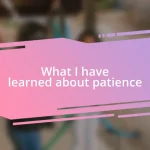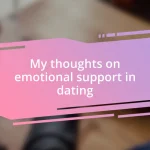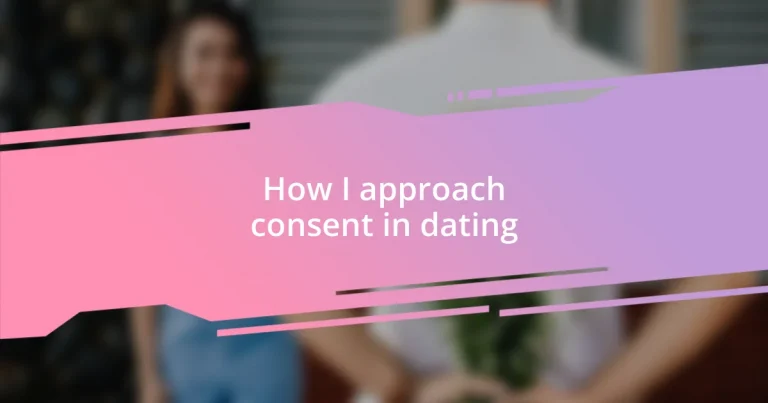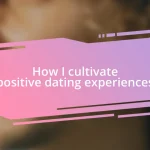Key takeaways:
- Consent in dating is an ongoing conversation rooted in trust, clarity, and the establishment of a safe space for both partners.
- Clear communication practices, such as regular check-ins and active listening, are vital for understanding boundaries and enhancing emotional connection.
- Revisiting consent discussions over time helps adapt to evolving feelings and strengthens mutual respect and intimate connection in the relationship.
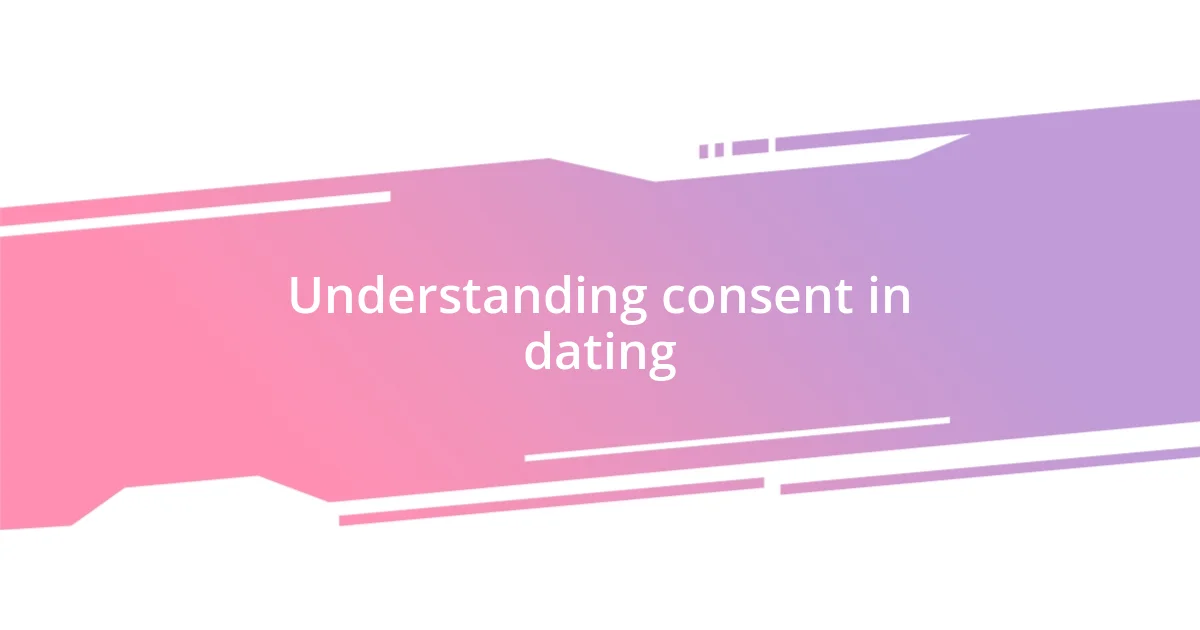
Understanding consent in dating
Understanding consent in dating is about more than just saying “yes” or “no.” It’s a continuous, ongoing conversation that grows deeper with trust and mutual respect. I’ve realized that clarity in communication can significantly enhance the connection I have with my partner—whether we’re discussing boundaries or simply checking in with each other’s feelings.
I remember a date where we both felt a bit nervous discussing our boundaries, but once we got into it, the conversation flowed naturally. It felt liberating to openly express what made us comfortable and what didn’t. It made me wonder—how often do we shy away from these discussions due to fear of judgment? I believe that facing those fears can greatly enrich our dating experiences.
When I think about consent, I’m reminded of how important it is to establish a safe space for both partners. Consent isn’t just about agreeing to something once; it’s about creating an ongoing dialogue. Have you ever found yourself hesitating to voice your needs? I’ve been there, and what I’ve learned is that the more I practice open communication, the easier those conversations become.
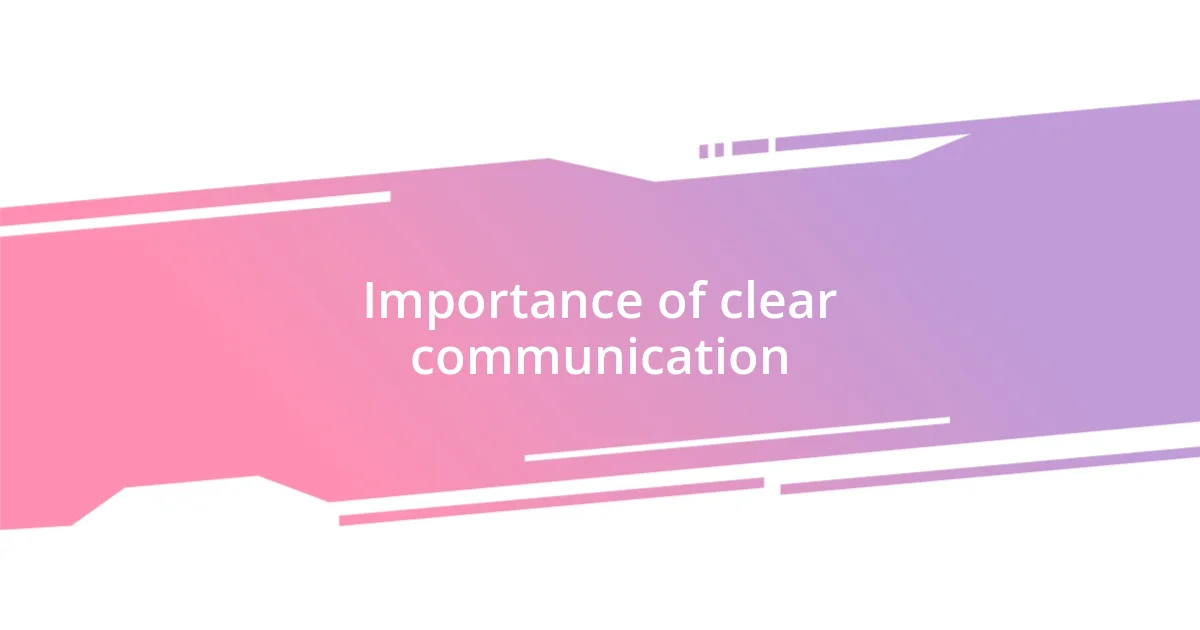
Importance of clear communication
Clear communication is the cornerstone of understanding consent in dating. When both partners are open about their feelings and boundaries, it creates an atmosphere of trust. I recall a time when my partner and I sat down specifically to discuss our comfort levels. Initially, it felt a bit awkward, but as we shared our thoughts, I could almost feel the tension melt away. That openness allowed us to connect on a deeper level, making every moment together feel more authentically enjoyable.
To ensure clarity in communication, I’ve found the following practices to be immensely helpful:
- Check-in regularly: Asking how your partner feels, even in the midst of a date, can keep the lines of communication open.
- Be direct: Instead of beating around the bush, expressing needs or concerns clearly prevents misunderstandings.
- Listen actively: It’s essential to not only speak your thoughts but also give your partner the space to share theirs without interruptions.
- Avoid assumptions: Never presume your partner’s feelings or desires; always ask for their perspective.
- Revisit boundaries: Conversations about consent aren’t one-time events. Regularly revisiting boundaries can help both partners feel secure and respected.
I find that these simple practices foster a supportive environment where both of us feel valued. The more I engage in these conversations, the more powerful and empowering our connection becomes.
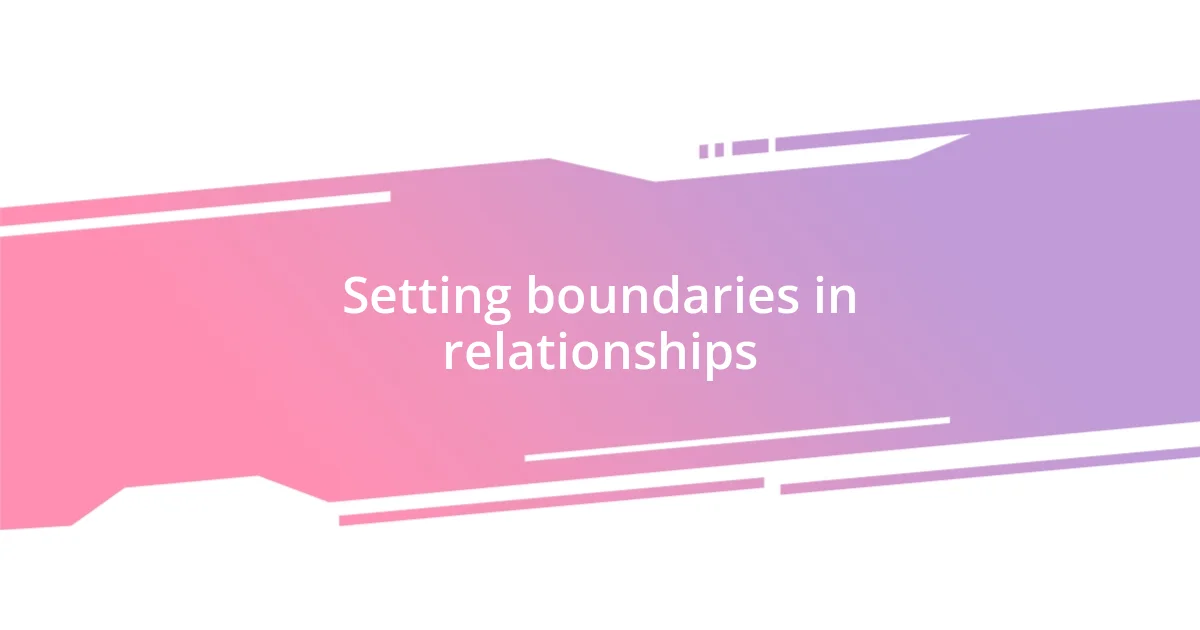
Setting boundaries in relationships
Setting boundaries is an essential part of any relationship. It’s about knowing where you stand and what you need to feel safe and respected. I vividly remember a time when I expressed my need for space during a particularly busy week. My partner’s understanding response helped reinforce the trust we had built, and it made me appreciate our dynamic even more. It taught me that boundaries can actually bring partners closer together, rather than push them apart.
Another instance that comes to mind is when I navigated a new romantic relationship and realized we had different comfort levels regarding public affection. Rather than assuming my partner understood my feelings, we discussed it openly. This exchange opened the door for us to learn more about each other’s perspectives and feelings, leading to a deeper emotional connection. It was a reminder that boundaries are not just restrictions; they are invitations for deeper understanding.
Ultimately, setting boundaries is an act of self-respect and respect for your partner. I greet boundary-setting with curiosity rather than fear. I ask myself: What do I need to feel comfortable? And equally, what does my partner need? It’s fascinating how addressing these questions together can create a partnership founded on mutual respect and understanding.
| Type of Boundaries | Examples |
|---|---|
| Emotional Boundaries | Discussing feelings and emotional needs |
| Physical Boundaries | Deciding on personal space and affection levels |
| Time Boundaries | Setting aside time for oneself |
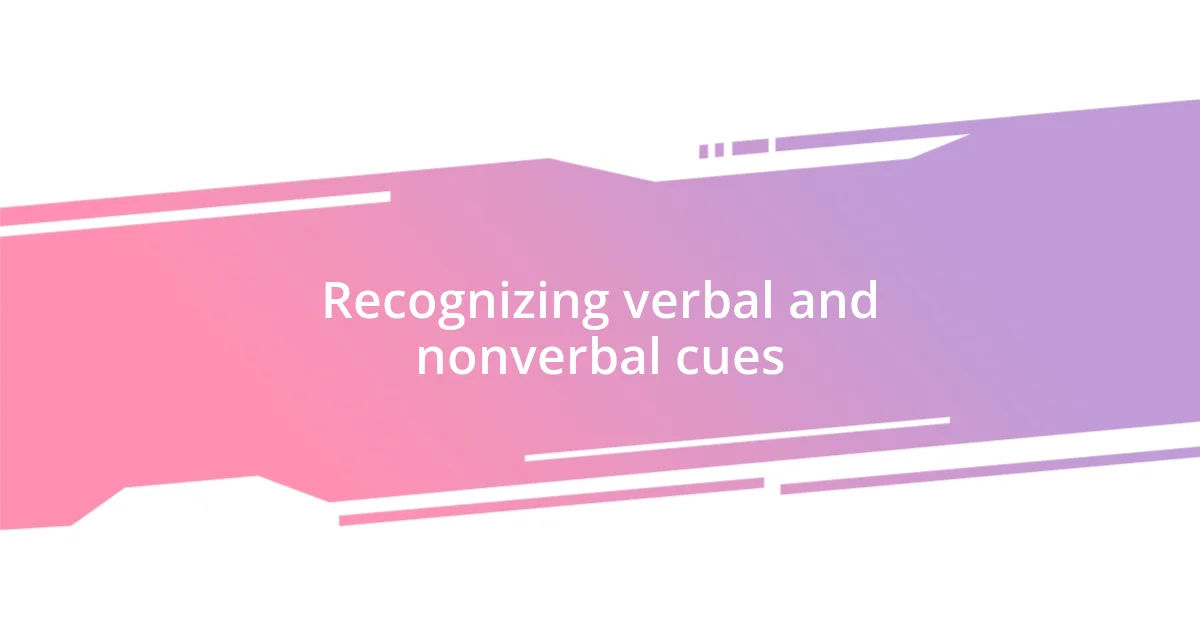
Recognizing verbal and nonverbal cues
Recognizing verbal and nonverbal cues in dating is an essential skill that can significantly enhance the dynamics of any relationship. The subtleties of communication are fascinating—sometimes, a simple glance can convey a heartfelt message. There was a moment on a date when I realized my partner’s slight shrug while I shared a story indicated uncertainty about the topic. Instead of brushing it off, I paused to address it, asking if they felt uncomfortable. This small interaction deepened our connection, as it unveiled layers of understanding we hadn’t explored yet.
Verbal cues are more than just the words we attach to feelings; they can reveal the true depths of our wants and needs. I once had a conversation where my partner mentioned being “fine,” but the tone was more hesitant than assuring. It made me reflect—what does “fine” really mean? Listening closely, I picked up on that little crack in their voice, prompting me to gently probe further. I learned that the willingness to explore the unspoken can lead to substantial emotional growth.
Nonverbal signals are equally captivating. From body language to facial expressions, these cues often reveal what words can’t. One day, while watching a movie together, I noticed my partner inching closer but hesitating to hold my hand. Rather than leaping to conclusions, I lightly squeezed their hand, an invitation to connect. Their immediate reaction was telling—they relaxed and intertwined their fingers with mine. It was a beautiful reminder that being attuned to each other’s silence can foster deeper intimacy than we might realize. What kinds of cues have you observed in your dating experiences that pushed the conversation forward?
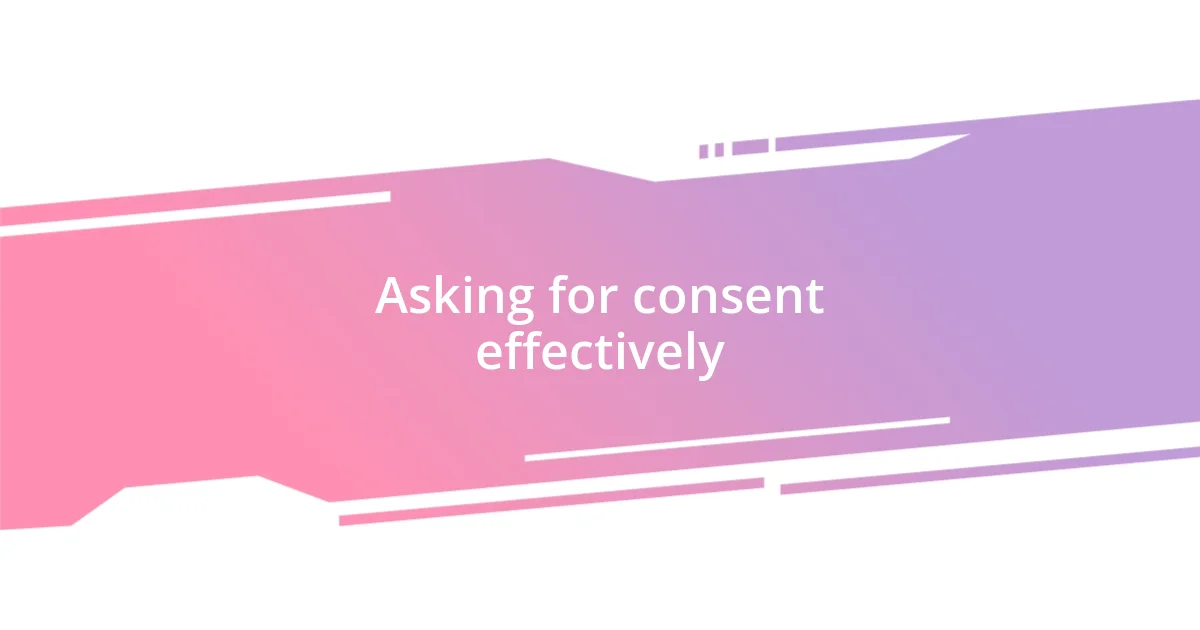
Asking for consent effectively
Asking for consent effectively requires attentive communication. I recall a date where we were both getting cozy, and I felt a flutter of excitement. Rather than assuming we were on the same page, I took a moment to softly say, “I’d love to kiss you if you’re okay with that.” That simple question not only made my partner smile but also created a space for mutual reassurance. It’s remarkable how asking directly can transform a moment into something much more profound, don’t you think?
It’s essential to frame your requests in a way that feels inviting, not demanding. I remember a time when I wanted to initiate something more intimate, and I approached it playfully. I said, “How would you feel about us enjoying some time together a little closer?” This approach turned what could have been an awkward question into a light-hearted moment. By using a tone that conveys warmth and curiosity, I found that it made the conversation flow more naturally, opening doors for honest responses.
Also, consider timing and setting as they can greatly enhance how your request is perceived. For instance, during a walk in the park, with the sun setting just right, I felt the mood was perfect to explore deeper intimacy. I gently asked, “Would you like to cuddle for a bit?” The tranquility of the moment allowed us both to lean into the question without the distraction of our busy lives. Effective consent isn’t just about the words; it’s about creating an atmosphere that invites genuine connection. How have your surroundings influenced how you approach consent?
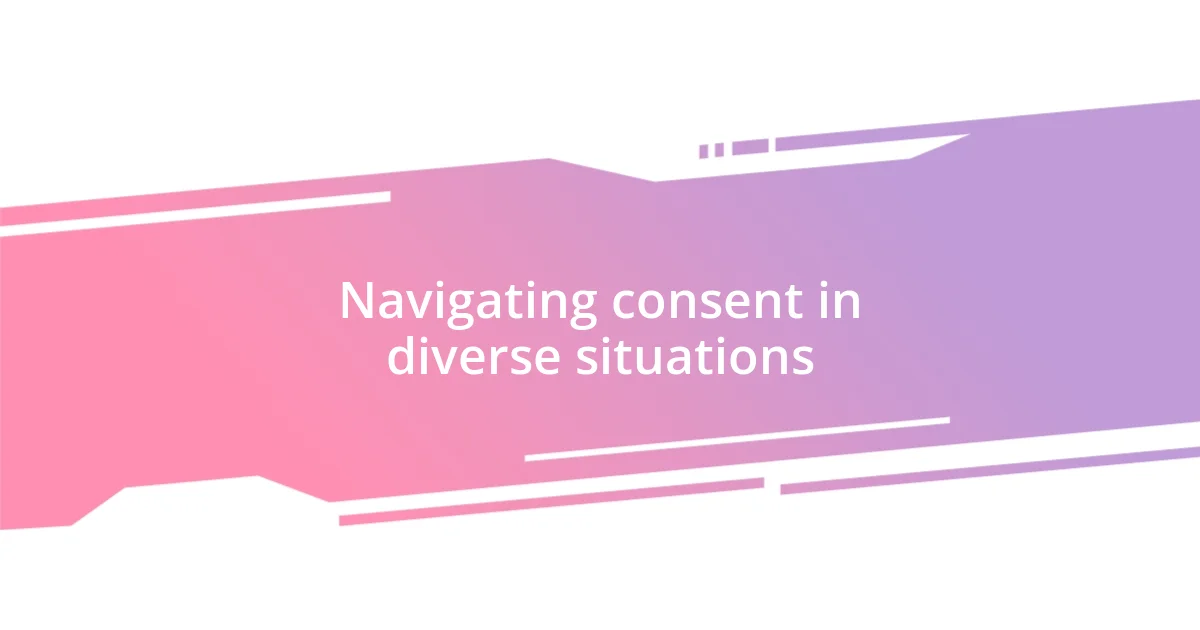
Navigating consent in diverse situations
Navigating consent requires a keen awareness of the context and the individuals involved. I once went on a camping trip with someone I was dating, surrounded by nature’s tranquility. As we shared a cozy campfire, I noticed how the intimacy shifted with each crackling sound. When I felt a natural drift toward snuggling on the blanket, I simply said, “This moment feels nice, doesn’t it? Can I wrap my arm around you?” This delicate inquiry turned an evening of stars into one of unforgettable closeness. It made me realize that setting and atmosphere can enhance understanding, don’t you think?
Every situation can have its unique dynamics, particularly in diverse dating scenarios. For example, I met someone through a mutual interest at a community event, and we clicked instantly. Yet, amid the lively discussions, I made it a point to check in with them. I asked, “Do you feel comfortable continuing this conversation outside, somewhere quieter?” It was a subtle way to gauge interest without imposing maybe something bigger. I learned that consent isn’t just about saying “yes” or “no”; it’s about ensuring that both people feel safe and willing to explore what comes next.
It’s fascinating how cultural backgrounds can influence perceptions of consent too. I once dated someone from a different culture, where expressions of affection were approached more conservatively. Realizing this, I chose to playfully inquire, “How do you feel about public displays of affection?” Their thoughtful response paved the way for deeper conversations about boundaries and expectations. It taught me that exploring consent is a two-way street, one that flourishes with patience and respect. How do your cultural experiences shape your understanding of consent in relationships?
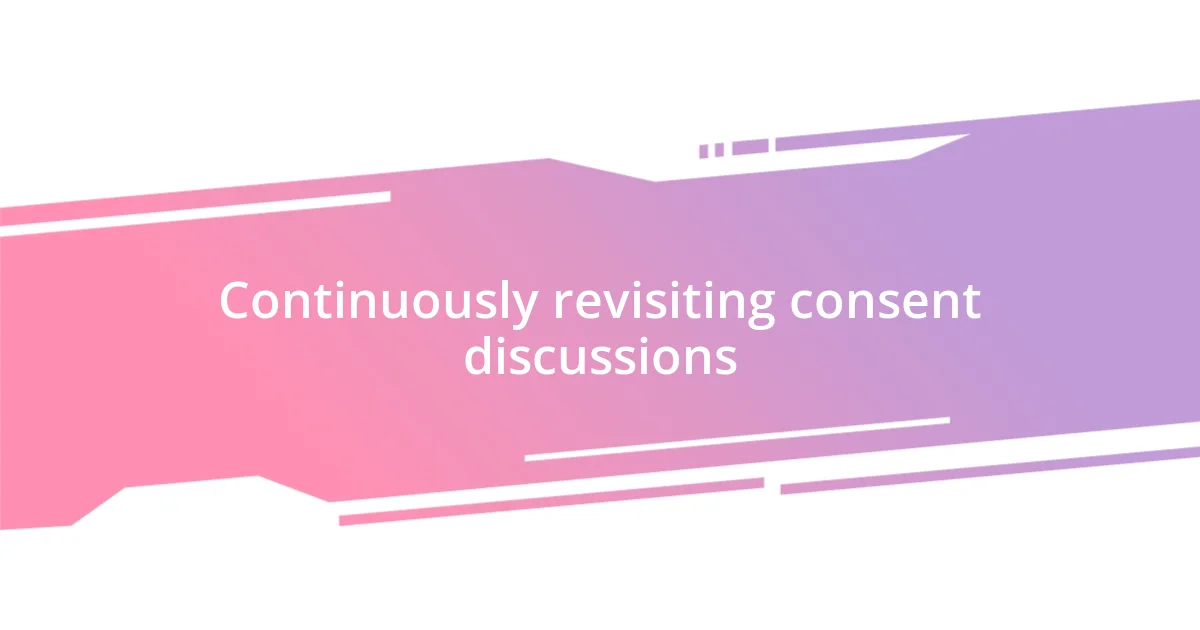
Continuously revisiting consent discussions
It’s important to revisit consent discussions consistently throughout a relationship, as feelings and comfort levels can evolve over time. I recall a relationship where, at a six-month mark, I felt it was crucial to check in with my partner. I said, “How do you feel about the pace of our intimacy? Are there any boundaries we should talk about?” The act of revisiting consent revealed new layers to our connection and reassured us both of our commitment to each other’s comfort.
I’ve found that ongoing conversations about consent allow for deeper trust and understanding. In a situation where I noticed my partner seemed a little hesitant during a physical moment, I paused and asked, “Is everything okay? Do you want to slow down?” This simple check-in not only relieved any potential tension but also reinforced a safe space where we could openly express our boundaries. It’s fascinating how such conversations can enhance both emotional intimacy and physical connection, don’t you agree?
Reinforcing the idea of consent creates a rhythm in the relationship that fosters open communication. Once, during a relaxed afternoon at home, I casually brought up the topic again by saying, “I really value how we communicate about our boundaries; it feels easy and safe.” This dialogue not only highlighted the importance of consent but also strengthened our bond, showing that it’s not just a one-time discussion but an ongoing journey. How do you navigate these conversations in your own experiences?








